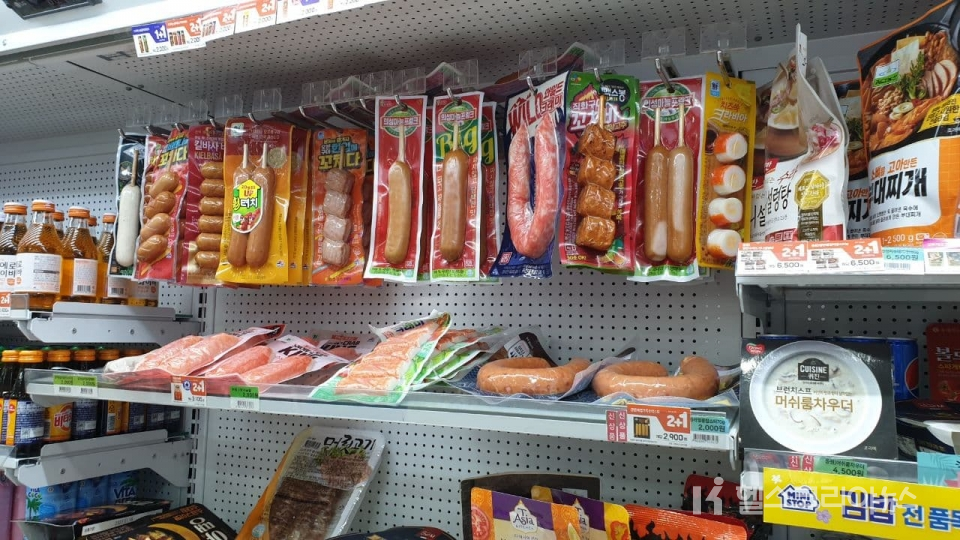While studying abroad in Korea, there are countless times when you need a quick and easy meal. Whether you’re trying to meet a deadline, cramming late at night, or grabbing a bite on your way back to the dorm after a part-time job, convenience store food becomes a lifesaver. But with so many products available, you might wonder, “Which ones actually taste good? What are the best food combos?” In this post, we’ll review popular convenience store items such as samgak-gimbap, instant ramen, cup rice, and lunch boxes, along with tasty pairing ideas (known as “honey combos”) involving soups, drinks, and side dishes.
1) Samgak-gimbap: Simple but full of variety
Samgak-gimbap (triangular rice ball) is one of the signature convenience foods in Korea. It’s a triangle-shaped rice ball wrapped in seaweed, filled with ingredients like tuna mayo, bulgogi, or stir-fried kimchi. Priced around 1,000–1,200 KRW, it’s affordable and hearty enough for a light meal with just one or two pieces.
- Best combo: Samgak-gimbap + cup ramen = the classic duo. Dip the gimbap into the ramen broth for a rice-and-noodle meal in one bite. You can also heat it briefly in a microwave for a softer texture.
- Tip: Follow the unwrapping order exactly to prevent tearing the seaweed and ensure a clean peel.
International student tip: Start with the mild “tuna mayo” flavor. Bold varieties like “Spicy Cheese Buldak” or “Galbi Heaven” exist, but they can be very spicy if you’re not used to heat.

2) Cup Ramen: Endless options from broth to spice
Convenience stores display rows of cup noodles in all kinds—Shin Ramen, Jin Ramen, Buldak noodles, udon-style, and more—priced around 1,000–2,000 KRW. Just add hot water and wait three minutes for a ready-to-eat meal, perfect for busy moments.
- Best combo: Cup ramen + samgak-gimbap or kimchi. After finishing the noodles, add rice into the leftover broth for extra comfort. You can also enhance flavor with cheese sticks or Spam slices.
- Caution: Some noodles (like the Buldak series) are intensely spicy and can upset your stomach on first try. Also, since they contain lots of sodium and additives, eat in moderation for better health.
International student tip: Most convenience stores have microwaves and water dispensers (hot and cold). After adding hot water to your noodles, briefly microwave to keep them extra hot.
3) Cup Rice: A complete rice meal in a cup
Cup rice combines rice with seasoned dishes like bulgogi, kimchi stew, or black bean sauce. Just add water or sauce and heat it in the microwave—ready in minutes. It’s a favorite for dorm and studio apartment residents who want a quick full meal.
- Examples: Pork donburi cup, kimchi roe rice, spicy pork over rice, and jjajang (black bean) rice. Just 2–3 minutes in the microwave and you’re good to go.
- Best combo: It can feel dry alone, so pair it with instant soup, a mini cup broth, or even a small salad or kimchi to make it more satisfying.
International student tip: Measure water and sauce carefully. Too much or too little can throw off the taste, so follow the instructions but adjust slightly to your preference.
4) Convenience Store Lunch Boxes: Well-balanced Korean-style meals
Korean convenience store lunch boxes come packed with rice and various side dishes (main meat dish, rolled omelet, sausage, kimchi, seasoned veggies, etc.), priced around 3,000–5,000 KRW. Options include ham & sausage boxes, bulgogi lunch boxes, and boneless fried chicken boxes. Some even feature soups like kimchi stew rice boxes.
- Pros: Microwave it for a quick one-person Korean meal. With multiple side dishes, it’s satisfying and less monotonous. Variants like chicken mayo bowls are also popular.
- Cons: Some items can get soggy or require mixing after heating. Also, since they have short shelf lives, it’s best to eat them soon after purchase.
International student tip: Some boxes highlight “spicy” or “low-calorie” on the label, so check those based on your taste and dietary needs. You can also find pork-free or seafood options by checking the ingredient list.
5) Drinks and Snacks Combos
Convenience stores in Korea also feature a huge variety of drinks and snacks, from coffee, carbonated beverages, and juices to chips, bread, and ice cream—all irresistible to browse.
- Drink pairing: Enjoy sparkling water (lemon flavor) or iced coffee with cup ramen for a clean balance. Korean traditional teas like yuja (citron) tea or corn silk tea are also worth trying.
- Snacks: New items keep appearing—potato chips, chocolate bars, sticky rice cakes, steamed buns—making each visit an adventure.
Pro tip: Many private-label (PB) products offer great value. Stores like 7-Eleven, CU, and GS25 often hold half-price promotions on PB drinks, jellies, or snacks—keep an eye on those event corners to discover new favorites.
6) Korea’s Unique “Combo Culture”
In Korea, creative combinations like “convenience store beer parties (Pyeon-maek)” and makeshift “ramen + sausage + rice cake = instant army stew” are wildly popular. Search “convenience store combo recipes” on social media or YouTube, and you’ll find endless quirky ideas.
Examples include: “pouring ramen broth over tuna-mayo gimbap” or “mixing cheese with Buldak noodles to make cheesy spicy pasta.” Such creative meals not only spark curiosity but also create fun memories among students living alone.
7) Health and Balance Tips
Although convenience store meals are delicious and convenient, many contain high levels of sodium and additives. For your health, try not to rely on them too frequently, and make sure to consume fresh vegetables and fruits regularly. To stay balanced, add cup salads, fruit cups, or bottled water to your meal.
Ideally, limit convenience store meals to 2–3 times a week and spend the rest on freshly cooked food—either from restaurants or your own cooking.
8) Using In-store Facilities
Most Korean convenience stores have microwaves, hot water dispensers, and even small dining tables, so you can heat and enjoy food right on site. It’s a perfect option for busy students, especially for defrosting frozen foods like pizza or fried rice for immediate dining.
However, smaller stores may require you to wait your turn, and microwaves can get crowded during peak hours—so it helps to find a nearby favorite store to frequent.
9) Regional Specialty Convenience Store Items
Some convenience stores offer limited-edition items featuring local specialties. For example, in Jeju Island, you might find Hallabong-flavored snacks or green tea bread made with local ingredients. In Busan, you’ll see more fish cake-related items. Exploring local convenience stores while traveling can be a fun and tasty experience.
International student tip: If you want to bring unique gifts or snacks back home, stop by local convenience stores. You may find quirky products unavailable in regular supermarkets or duty-free shops.
10) Conclusion
Korean convenience stores are more than just quick-meal stops—they’re like small treasure chests full of variety, creativity, and tasty food combos. From samgak-gimbap and ramen to cup rice and lunch boxes, the combinations and variations are endless. For international students, they’re perfect for late-night study snacks or quick meals during exam season—and exploring new products with friends can be a delightful memory in itself.
Of course, moderation and balance are key—pair these foods with veggies or fruits whenever possible. Still, with 24-hour service, rich product lines, and fun combo recipes, Korean convenience stores offer a taste of everyday comfort. So give the classic combo—cup ramen, gimbap, and an ice-cold drink—a try someday. You’ll discover the cozy side of Korean daily life and its small but satisfying joys.

WeBring Service : Provides personalized services to foreigners living in Korea
Exclusive offer: Introducing foreign car rental in Korea, WeBring-SoCar

